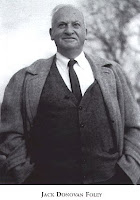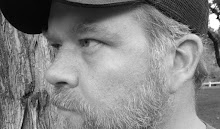
This article is a copy of a copy of a copy. I do not know who wrote it or I would gladly give them credit. I am not seeling it and so if I am infringing on someones copyright, please let me know.
Jack Foley was a technician in Hollywood who is credited with creating the modern way of adding sound effects to movies, here is his story:
The Story of Jack Foley
Like many other workers in post production, I heard the terms foley studio, foley sheets, foley footsteps, foley reels, foley walker, foley editor, without fully realizing, for some years, that the term foley was the name of a man. Perhaps that's because I never worked at Universal Studio. Yes, Jack Foley was quite a man and his many contributions to the art of sound effects is a story in itself.
Jack Foley started in the motion picture business in the silent picture era and lived through the exciting times when overnight the industry converted to sound moving pictures. I became intrigued with the man and, through the help of his former co-workers, friends, and his daughter, I've pieced together the career of a most remarkable man. Jack was truly adaptable in a period of change, a jack-of-all-trades and master of them all.
Jack was born in Yorkville, N.Y. in 1891, and was raised in the Seagate section of Coney Island. He went to Public School No. 158. His classmates were James Cagney, Arthur Murray, and Bert Lahr. His first job was as a general order clerk on the New York docks. During this period, Jack met Cary Grant, who was a stilt walker at Coney Island. Jack also played a lot of semi-pro baseball in the New York area, which sparked his lifelong interest in sports.
Dissatisfied with the weather, Jack moved to California. His first job was as a double and stunt man. One of his studio acquaintances introduced Jack to the rugged beauty of the California's Sierra Mountains and surrounding Owens Valley. It was to become a lifetime love affair.
Jack moved to Bishop during World War I, and served his country as part of The American Defense Society, a group guarding the water supply of Los Angeles to prevent sabotage-poison being put into the water. Jack raised his family in Bishop and went to work in a local hardware store. Here Jack became interested in little theater and wrote articles for the local newspaper. A rival newspaper in Lone Pine reported one of Jack's theatrical endeavors, "'Stop Thief', a play, is being put on by Jack Foley, the only non-henpecked Irish husband in America, is a member of the cast. That fact, within itself, is worth the price of admission."
When the farmers of the Owens Valley sold their farms to the City of Los Angeles for water rights, the people of Bishop faced a bleak future.
Jack soon convinced the town's storekeepers that Bishop had much to gain by luring filmmakers to that area, and he mounted a publicity campaign to attract the studios northward. He was very successful, and became a location scout for numerous productions. The area, bound by snow capped mountains, beautiful valleys, and a scarcity of people, made it ideal for westerns.
Making the most of his studio contacts, Jack became Benny's director. Now Jack revealed another talent. He sold a number of scripts to Universal which were produced. When not busy directing silent films, Jack kept himself busy directing inserts for the studio. Inserts are the close-ups of movements, such as a hand picking up a gun, which are not bothered with during normal shooting. Jack prepared the sets, graphics, props, models, whatever was necessary, either doing it himself or arranging for it to be done.
Almost overnight, sound was introduced. In the forefront was Warner Brothers with its Vitaphone recording system. In the wings, Western Electric was readying it's photographic system. Jack, writing in 1952 in the Universal International Studio Club News, had this to say in retrospect about these exciting times: "The Warner kids on the neighboring ranch had just come up with a sound picture 'The Jazz Singer' while the hard riding, cliff-hanging shoot-from-the-hip boys on the U ranch were complacently rounding up the last few scenes of the great American musical, 'Showboat', a SILENT picture. Faces around here were so red someone yelled 'The Indians are going!' Someone asked, 'are we still in business?'"
Jack continued, "Most of the studios were in the same fix. Western Electric could only promise equipment in the future, but there was one Fox-Case portable unit that was being loaned here and there for a week's study and tests so that the studios could start breaking in men for sound procedure." Jack described the studio's hunt through all departments for personnel even remotely knowledgeable about radio and applied arts. Then, "...the volunteers cautiously advanced and surrounded the Fox-Case. After three days of watchful waiting, the strain started to tell on a group that was used to shooting sixty or more scenes a day, and someone said 'Let's shoot craps or shoot a picture.' And so they spent the next three days and nights making "Melody Of Love..."
"The industry was not so happy about the U camp jumping the gun, and all we could say was 'Hell, we didn't know it was loaded!' or words to that effect."
Jack's article was not so clear as to actual sequence of events, but evidently a composite music and effects track was then added to the hitherto silent "Showboat". The music and effects were added simultaneously and the first "Foley" session was born. Jack describes it: "Then Stage 10 swayed to the rhythm of a 40-piece orchestra under the direction of Joe Cherniavsky as he scored "Showboat" and the rest of us watched the screen with him putting in the sound effects of the 'Showboat', 'Dat Ole' Ribber' and the laughter and cheers as it jus' kept rolling along. And with 'Showboat' on it's way, other pictures on the silent stages came in for sound shots." Jack illustrated his article with the accompanying drawing, which also shows his talent as an artist. Jack had a regular (usually illustrated) column in the Universal International Studio Club News.
He was a humorist and wrote under the synonym of Joe Hyde. To understand the significance, you must know that Joe Hyde was a studio cleanup man, who spent his working time pushing his cart around the studio lot sweeping up cigarettes and other debris. Joe enjoyed the notoriety, and Jack Foley continued the charade until Joe's death. At that pint, Jack revealed himself and henceforth called his column "And That's The Way I Heard It." He continued his pointed humor lampooning studio people, technicians, actors, stunt men, and executives alike.
As sound was added to picture after picture, Jack was called upon to add the sound effects. "Jack's technique was to record all the effects for a reel at one time," explained George Pal, who used Jack's talent on some of his pictures. "Jack added the footsteps, the movement, the sound of various props-all in one track. He used a cane as an adjunct to his own footsteps. With that cane, he could make the footsteps of two to three people. He kept a large cloth in his pocket which could be used to simulate movement."
Fellow workers say that the results of a Jack Foley session were as good as what young editors get today cutting twenty tracks. Joe Sikorsky, who worked with Jack, recalls, "Jack emphasized you have to act the scene... you have to be the actors and get into the spirit of the story the same as the actors did, on the set. It makes a big difference."
When there were too many effects to handle, Jack enlisted the aid of the prop men who brought him props. They evidently stayed around all day, and he put them to work. He occasionally pressed his friend Walter Brennan into helping him. Jack told Brennan to put a rock in his shoe. He did, and the limp that resulted became Brennan's trademark.
The anecdotes surrounding Jack's strange profession grew as Hollywood columnists discovered his behind-the-scenes activities. The movie "Spartacus" showed scenes of slaves walking in leg chains. The director was all set to return to Italy and restage the scene to capture the sound effects. Jack stepped in and did the whole sequence with footsteps and key chains.
The movie "Pink Submarine" needed a comical motor sound. Jack is reputed to have reversed a burp and looped it for the effect.
The director of a melodrama had a step rigged to make a squeak when the leading lady descended a flight of stairs. After many unsuccessful takes, Jack was called in. He explained how to do it, "I won't add the creak until the film has been cut together into a rough print. The I'll park myself in an old rocking chair in front of a microphone-and when the lady's foot hits the fourth step, I'll just rock, myself back slowly.
Jack, estimated that he walked 5000 miles in the studio doing footsteps. He characterized the footsteps of stars in this manner: "Rock Hudson is a solid stepper; Tony Curtis has a brisk foot; Audie Murphy is springy; James Cagney is clipped; Marlon Brando soft; John Saxon nervous."
"Women are the toughest to imitate," he confided, "my 250 pounds may have something to do with it, but the important thing is their steps are quicker and closer together. I get winded doing leading ladies. Jean Simmons is almost, not quite, the fastest on her screen feet in all of Hollywood. She's topped only by June Allyson. I can't keep up with her at all."
Jack received a number of awards, including the Golden Reel Award, voted by his fellow sound effect practitioners, members of the Motion Picture Sound Editors. Jack passed away in 1967. But his name lives on in practically every studio in the world. What better tribute to an amazing, versatile, and energetic pioneer of our business. We will remember you, Jack Foley.










